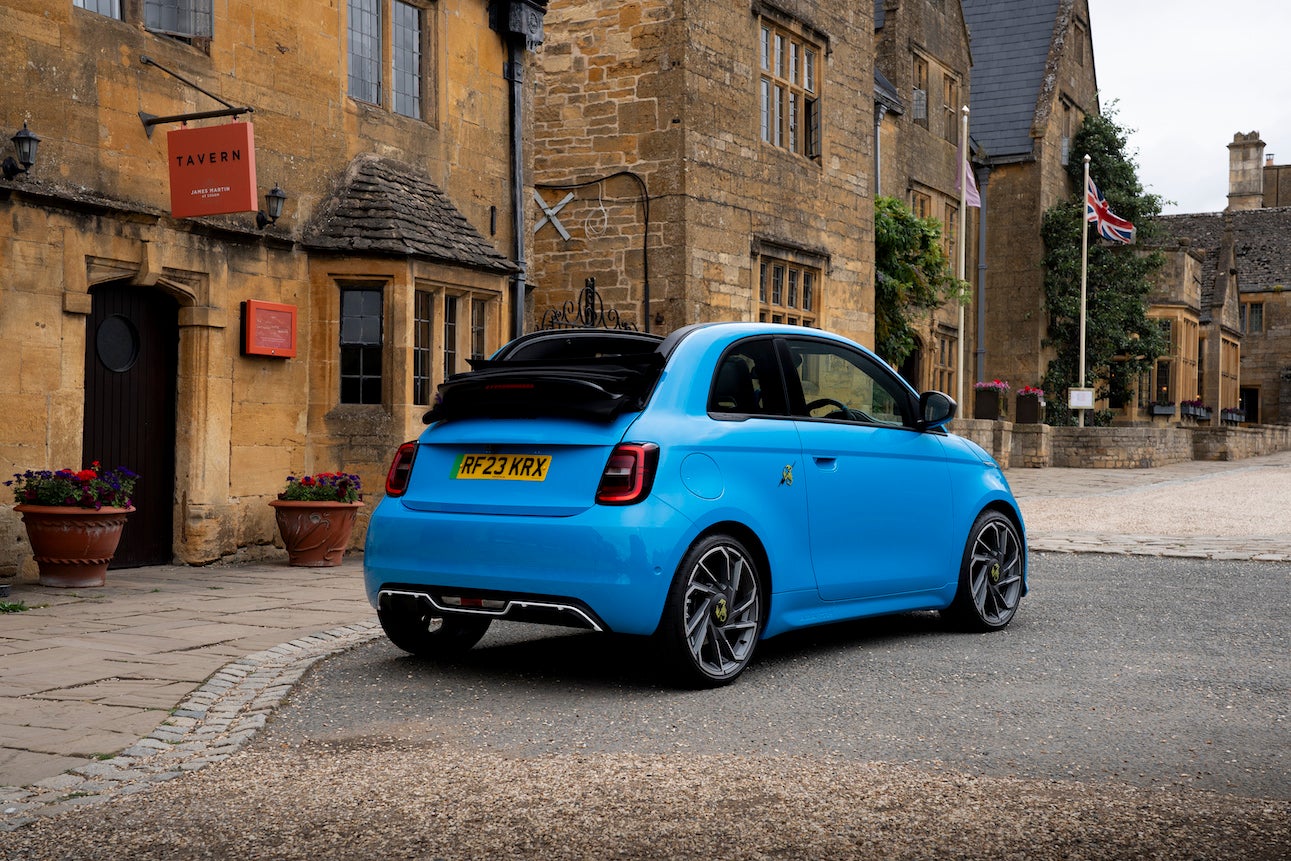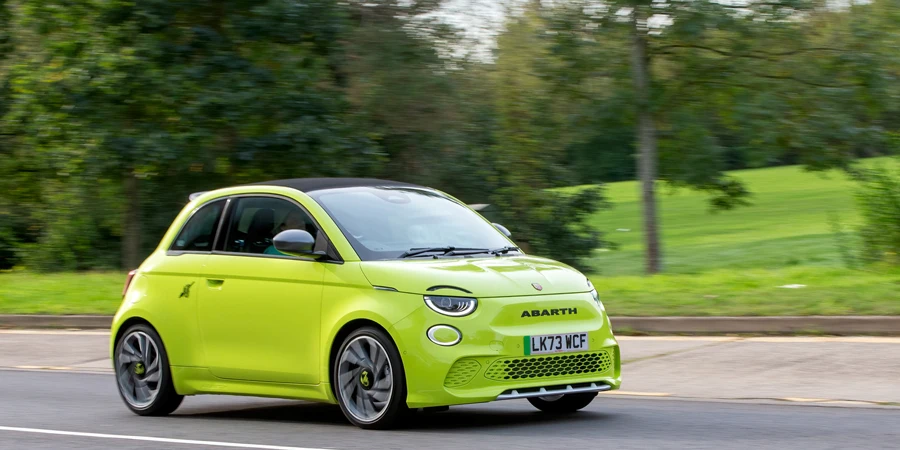The Abarth 500e brings high style – and in top-spec form, pricing – to the electric A segment.

The first electric Abarth is a little more removed from the Fiat 500e than it might appear at first glance. The platform is identical, as is the body, yet when it comes to energy storage and propulsion, things differ. They would want to: the test vehicle was priced north of forty thousand pounds. More on how Stellantis aims to justify that shortly.
Extra wings and splitters feature at either end, 17 (standard) or 18-inch (Turismo trim level) wheels are unique to the Abarth, scorpion logos slashed by a lightning bolt are attached to the sides of the car and the brand name appears front and rear. They don’t sound like much yet along with a few other modifications, the effect is convincing, especially when the palette of arresting colours is thrown into the mix.
Why no 3+1?
The car supplied for the test was painted a particularly striking shade of blue, one of two new-to-the-500e hues, the other being Acid Green. Would we consider bright paintwork a premium detail? Perhaps. It certainly helps to get the car noticed, something another feature which is standard in the UK but optional in most other countries, accentuates. This is called the Sound Generator and it is fitted to all four cars: 500e, 500e Turismo, 500e convertible and 500e Turismo convertible. Unlike the Fiat, there is no 3+1 body option.
Consisting of a recorded sound broadcast through a waterproof speaker positioned below the boot, the effect of the Sound Generator varies from amusing to almost annoying. Personally, I love it, helping as it does to get a debate going about how to give EVs some character. After all, why pay all that money for what is supposed to be a dinky demon if it isn’t going to reward your ears? A pity the noise doesn’t impersonate rising and falling revs; it merely becomes louder the faster you go. Not so great on a long journey.
Another thing I would change about the exterior speaker is being unable to activate/deactivate it above five kilometres an hour. That’s right: you must be almost stopped for the relevant function to be selectable in the instrumentation cluster. Hit the left button on the steering wheel to scroll and either add or remove the tick. It takes but a second and will likely amuse or startle pedestrians. Flicking it straight off again to see another instant double-take is fun (and OK, childish).
High-spec interior
None of those gloss-black switches on the helm is haptic, for which some of us will loudly applaud Stellantis. It’s the same deal with the four big P R N and D buttons smack bang in the middle of the lower dashboard. HVAC functions are similarly taken care of by physical switches. More clapping. By the way, anyone else notice Hyundai has brought them back for the facelifted Tucson – I noticed this in the official images revealed to the media in November. Hopefully the start of a trend back to a safety and convenience first approach.
Another terrific thing which marks out the 500e is basically zero steering wheel jerking. How especially awful that would be in such a beautifully balanced and fun-fast hot hatch. I will soon be sampling the revised ID.3 as well as the ID.7 and am hoping Volkswagen has respectively fixed and not corrupted in the first place these new cars’ steering systems.
Some other lovely things which delight the senses in the Abarth are metal-surfaced pedals, and Alcantara trim on those parts of the steering wheel which fingers come into contact with. The same fabric is used to cover many of the cabin’s surfaces. Yes, it does give an impression of luxury and helps to justify what can be steep pricing.
What was wrong with just mechanical latches?
One, or rather two silly at best and dangerous at worst things inside this car are small, illuminated circles on each door. Touch to open: simple, yes? And yet none of my passengers could work out how to get out of the car until instructed to press that ring of light.
Emergency releases exist yet imagine trying to locate one in the seconds after a collision with power automatically cut. And consider an unlikely but possible thermal runaway from the battery. How would those in the back seats reach one of these handles hidden under door armrests, should they even know about them? Stellantis: kill the electric buttons (on the outside too) and just have easy-reached catches in their place. Exterior pull-handles too please.
Those rear-seat occupants will probably be kids and this is a very small car and space in the back is fairly squeezy. The same applies to the boot, capacity being 185 litres (550 seats down). Incidentally, if the concertina canvas roof is in the lowest of two positions, it will automatically retract by a few centimetres to allow the boot lid to be opened. A nice bit of engineering theatre. Against that, rearward visibility is quite restricted even when the top is in the lower of those two positions.
Three driving modes and two power outputs
One thing which is unusual for an EV is the lack of a specific one-pedal driving option. Normally this is activated or deactived via a screen but in the 500e there are instead three driving programmes. These you select via a little switch. Two of them – Scorpion Track and Scorpion Street – allow all 114 kilowatts but in Turismo mode, power is restricted to 100 kW and torque drops by 15 Nm to 220 Nm. Scorpion Track is the only one which excludes one-pedal drive: a real shame for those who would like to maximise range but cannot get along with the constant drag effect typical of all o-p d systems.
Having put all the things which compromise the 500e on the record, I have to say I adored my week with this car. So what that there is no heating for the steering wheel; the seats at least have it and I was more than warm enough during a cold spell. Roof open? Of course. How extra delightful it would be on a spring day or evening.
As entertaining as an Abarth 595?
The Abarth feels faster to 62 mph than the official seven seconds, with the top speed being 96 mph. The thing darts in and out of corners, has hardly any body roll and roundabouts are a hoot.
Not only is the 57/43 per cent front/rear spread of mass a factor in what is great handling but the weight of the car itself: 1,410 (hatchback) or 1,435 kg (convertible). Yes, 42.2 kWh isn’t much by the way of capacity – real world winter range can be as low as 100 miles – but the battery contributes just 295 kilos. Stick to low-speeds and you could instead see way more than 150 miles.
There is no front boot due to various components being located there, though the cells cluster pack is instead positioned under the car, mainly to the mid-rear and within the wheelbase. Which gives it quite a different feel to the other Abarth 500.
Petrol or electric?
Throwing the 500e around reveals it to be way less feral than its older and smaller petrol-powered brothers and for some that will be a disappointment. And yet the EV is the faster car.
Stellantis has given Abarth two bites of the cherry, with die-hard enthusiasts continuing to be catered for (I myself love both cars). Each 500 – old and new – is surely nicely profitable too. How rapidly this industry is changing – Sergio Marchionne noted publicly that FCA lost a lot of money on every electric Fiat 500, remember – and how thrilling that some EVs are now cars we would recommend to our friends.
The Abarth 500e is priced from GBP34,195 (GBP41,195 in as-tested Turismo convertible form). The WLTP maximum range for the four-variant line-up is 150-164 miles (trim level dependent) and rapid charging is at up to 85 kW.
Source from Just Auto
Disclaimer: The information set forth above is provided by just-auto.com independently of Alibaba.com. Alibaba.com makes no representation and warranties as to the quality and reliability of the seller and products.




